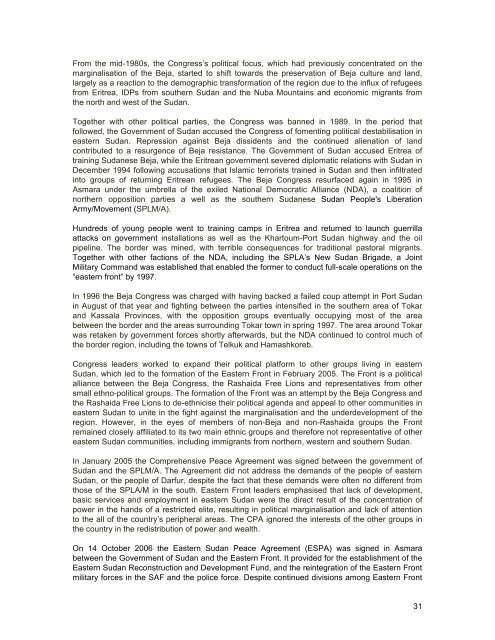SUDAN: Durable solutions elusive as southern IDPs return and ...
SUDAN: Durable solutions elusive as southern IDPs return and ...
SUDAN: Durable solutions elusive as southern IDPs return and ...
You also want an ePaper? Increase the reach of your titles
YUMPU automatically turns print PDFs into web optimized ePapers that Google loves.
From the mid-1980s, the Congress’s political focus, which had previously concentrated on the<br />
marginalisation of the Beja, started to shift towards the preservation of Beja culture <strong>and</strong> l<strong>and</strong>,<br />
largely <strong>as</strong> a reaction to the demographic transformation of the region due to the influx of refugees<br />
from Eritrea, <strong>IDPs</strong> from <strong>southern</strong> Sudan <strong>and</strong> the Nuba Mountains <strong>and</strong> economic migrants from<br />
the north <strong>and</strong> west of the Sudan.<br />
Together with other political parties, the Congress w<strong>as</strong> banned in 1989. In the period that<br />
followed, the Government of Sudan accused the Congress of fomenting political destabilisation in<br />
e<strong>as</strong>tern Sudan. Repression against Beja dissidents <strong>and</strong> the continued alienation of l<strong>and</strong><br />
contributed to a resurgence of Beja resistance. The Government of Sudan accused Eritrea of<br />
training Sudanese Beja, while the Eritrean government severed diplomatic relations with Sudan in<br />
December 1994 following accusations that Islamic terrorists trained in Sudan <strong>and</strong> then infiltrated<br />
into groups of <strong>return</strong>ing Eritrean refugees. The Beja Congress resurfaced again in 1995 in<br />
Asmara under the umbrella of the exiled National Democratic Alliance (NDA), a coalition of<br />
northern opposition parties a well <strong>as</strong> the <strong>southern</strong> Sudanese Sudan People's Liberation<br />
Army/Movement (SPLM/A).<br />
Hundreds of young people went to training camps in Eritrea <strong>and</strong> <strong>return</strong>ed to launch guerrilla<br />
attacks on government installations <strong>as</strong> well <strong>as</strong> the Khartoum-Port Sudan highway <strong>and</strong> the oil<br />
pipeline. The border w<strong>as</strong> mined, with terrible consequences for traditional p<strong>as</strong>toral migrants.<br />
Together with other factions of the NDA, including the SPLA’s New Sudan Brigade, a Joint<br />
Military Comm<strong>and</strong> w<strong>as</strong> established that enabled the former to conduct full-scale operations on the<br />
“e<strong>as</strong>tern front” by 1997.<br />
In 1996 the Beja Congress w<strong>as</strong> charged with having backed a failed coup attempt in Port Sudan<br />
in August of that year <strong>and</strong> fighting between the parties intensified in the <strong>southern</strong> area of Tokar<br />
<strong>and</strong> K<strong>as</strong>sala Provinces, with the opposition groups eventually occupying most of the area<br />
between the border <strong>and</strong> the are<strong>as</strong> surrounding Tokar town in spring 1997. The area around Tokar<br />
w<strong>as</strong> retaken by government forces shortly afterwards, but the NDA continued to control much of<br />
the border region, including the towns of Telkuk <strong>and</strong> Ham<strong>as</strong>hkoreb.<br />
Congress leaders worked to exp<strong>and</strong> their political platform to other groups living in e<strong>as</strong>tern<br />
Sudan, which led to the formation of the E<strong>as</strong>tern Front in February 2005. The Front is a political<br />
alliance between the Beja Congress, the R<strong>as</strong>haida Free Lions <strong>and</strong> representatives from other<br />
small ethno-political groups. The formation of the Front w<strong>as</strong> an attempt by the Beja Congress <strong>and</strong><br />
the R<strong>as</strong>haida Free Lions to de-ethnicise their political agenda <strong>and</strong> appeal to other communities in<br />
e<strong>as</strong>tern Sudan to unite in the fight against the marginalisation <strong>and</strong> the underdevelopment of the<br />
region. However, in the eyes of members of non-Beja <strong>and</strong> non-R<strong>as</strong>haida groups the Front<br />
remained closely affiliated to its two main ethnic groups <strong>and</strong> therefore not representative of other<br />
e<strong>as</strong>tern Sudan communities, including immigrants from northern, western <strong>and</strong> <strong>southern</strong> Sudan.<br />
In January 2005 the Comprehensive Peace Agreement w<strong>as</strong> signed between the government of<br />
Sudan <strong>and</strong> the SPLM/A. The Agreement did not address the dem<strong>and</strong>s of the people of e<strong>as</strong>tern<br />
Sudan, or the people of Darfur, despite the fact that these dem<strong>and</strong>s were often no different from<br />
those of the SPLA/M in the south. E<strong>as</strong>tern Front leaders emph<strong>as</strong>ised that lack of development,<br />
b<strong>as</strong>ic services <strong>and</strong> employment in e<strong>as</strong>tern Sudan were the direct result of the concentration of<br />
power in the h<strong>and</strong>s of a restricted elite, resulting in political marginalisation <strong>and</strong> lack of attention<br />
to the all of the country’s peripheral are<strong>as</strong>. The CPA ignored the interests of the other groups in<br />
the country in the redistribution of power <strong>and</strong> wealth.<br />
On 14 October 2006 the E<strong>as</strong>tern Sudan Peace Agreement (ESPA) w<strong>as</strong> signed in Asmara<br />
between the Government of Sudan <strong>and</strong> the E<strong>as</strong>tern Front. It provided for the establishment of the<br />
E<strong>as</strong>tern Sudan Reconstruction <strong>and</strong> Development Fund, <strong>and</strong> the reintegration of the E<strong>as</strong>tern Front<br />
military forces in the SAF <strong>and</strong> the police force. Despite continued divisions among E<strong>as</strong>tern Front<br />
31
















